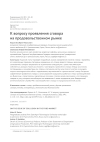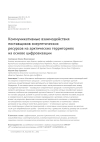On the issue of collusion in the food market
DOI: 10.33917/mic-5.106.2022.110-115
This article provides a detailed analysis of the definitions of the concepts of conversations and identifies its characteristic features. The authors determined that collusion is a secret illegal agreement, which is aimed at limiting competition in order to maximize their own income. Also considered are such forms of manifestation of collusion between the customer, suppliers and competitors as “ramming”, passive participation or refusal to participate in the tender, submission of an uncompetitive proposal, vertical and horizontal collusion. The modern manifestations of collusion with the use of auction robots and measures to counter their use are disclosed. The characteristic signs of collusion between the customer and the supplier of goods that contribute to its identification are identified and presented. It also defines the role of the Federal Antimonopoly Service in countering collusion in the food market.
References:
1. Dahl V. Explanatory Dictionary of the Living Great Russian Language: in 4 volumes. M., 1989-1991. T. 4. (In Russ.).
2. Esipov V.E. Prices and pricing: A textbook for universities. 3rd ed. St. Petersburg: Publishing house «Piter», 1999. 161 p. (In Russ.).
3. Ivanova E.S. Evolution of the development of price collusion: legal and economic aspects // Izvestiya FEFU. Economics and Management. 2019:2;5-21. (In Russ.).
4. Kinev A.Yu. The fight against bid rigging is a way to reduce state costs // Lawyer. 2016:1;14-19. (In Russ.).
5. Kononov S. Tender collusion. How to understand that the auction is fair and not waste time in vain. URL: https://vc.ru/u/889970-cornerstone/306564-tendernye-sgovory-kak-ponyat-chto-torgi-chestnye-i-ne-potratit-vremya-zrya
6. Kutsenko V.E. Price collusion // Innovative science. 2017:1-1:128-130. (In Russ.).
7. Lozovsky L.Sh. Universal business dictionary. / L.Sh. Lozovsky, B.A. Raizberg, A.A. Ratnovsky. M.: INFRA-M, 1999. 640 p. (In Russ.).
8. Malyutina O.A. Bid rigging: legal aspects of counteraction // Bulletin of the Nizhny Novgorod Academy of the Ministry of Internal Affairs of Russia. 2016:4 (36);122-127. (In Russ.).
9. Raizberg B.A. Modern Economic Dictionary 2nd ed., Corrected. / B.A. Raizberg, L.Sh. Lozovsky, E.B. Starodubtseva. M.: INFRA-M, 1999. 479 p.
10. Smith A. Research on the nature and causes of the wealth of nations; [per. from English. P. Klyukina]. Moscow: Eksmo, 2022. 1056 p.
11. Telkov A.V. Some aspects of the protection of national projects through operational-search activity // Bulletin of the Tula State University. Economic and legal sciences. 2021:3;117-125. (In Russ.).
12. Ushakov D.N. Explanatory Dictionary. URL: https://ushakovdictionary.ru/word.php?wordid=68664
13. Finam Financial Dictionary. URL: https://www.finam.ru/dictionary/wordf00589/













